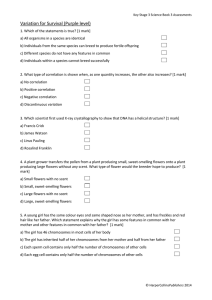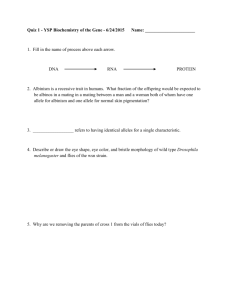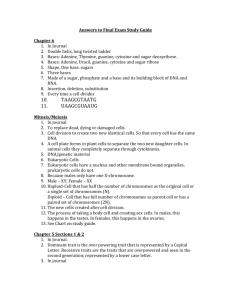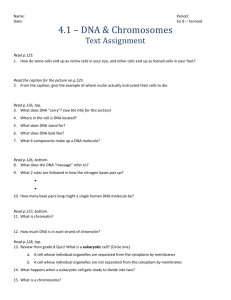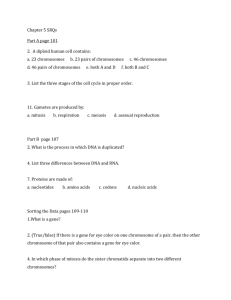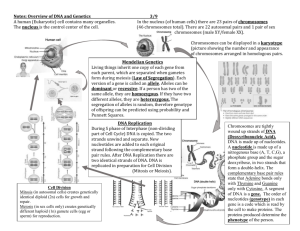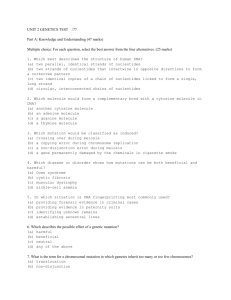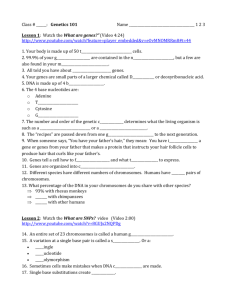Variation_for_Survival_Orange_Questions
advertisement
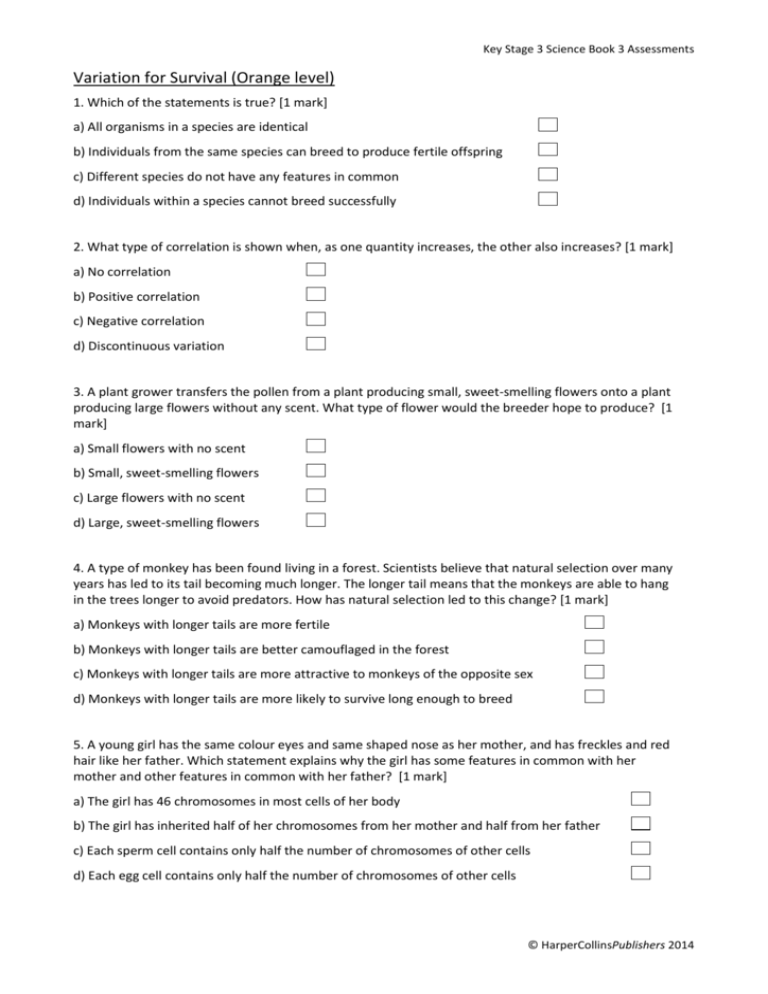
Key Stage 3 Science Book 3 Assessments Variation for Survival (Orange level) 1. Which of the statements is true? [1 mark] a) All organisms in a species are identical b) Individuals from the same species can breed to produce fertile offspring c) Different species do not have any features in common d) Individuals within a species cannot breed successfully 2. What type of correlation is shown when, as one quantity increases, the other also increases? [1 mark] a) No correlation b) Positive correlation c) Negative correlation d) Discontinuous variation 3. A plant grower transfers the pollen from a plant producing small, sweet-smelling flowers onto a plant producing large flowers without any scent. What type of flower would the breeder hope to produce? [1 mark] a) Small flowers with no scent b) Small, sweet-smelling flowers c) Large flowers with no scent d) Large, sweet-smelling flowers 4. A type of monkey has been found living in a forest. Scientists believe that natural selection over many years has led to its tail becoming much longer. The longer tail means that the monkeys are able to hang in the trees longer to avoid predators. How has natural selection led to this change? [1 mark] a) Monkeys with longer tails are more fertile b) Monkeys with longer tails are better camouflaged in the forest c) Monkeys with longer tails are more attractive to monkeys of the opposite sex d) Monkeys with longer tails are more likely to survive long enough to breed 5. A young girl has the same colour eyes and same shaped nose as her mother, and has freckles and red hair like her father. Which statement explains why the girl has some features in common with her mother and other features in common with her father? [1 mark] a) The girl has 46 chromosomes in most cells of her body b) The girl has inherited half of her chromosomes from her mother and half from her father c) Each sperm cell contains only half the number of chromosomes of other cells d) Each egg cell contains only half the number of chromosomes of other cells © HarperCollinsPublishers 2014 Key Stage 3 Science Book 3 Assessments 6. Different species of birds have beaks of different shapes, sizes and colours. Which of these ideas is not supported by this evidence? (1 mark) a) Different species have a different diet b) Different species have evolved in different ways c) All birds have beaks d) Different species evolved at different times 7. Match each description with the correct word. [1 mark] Thread-like strands of DNA that carry genetic information Gene Control the development of individual characteristics Chromosome The chemical from which chromosomes are made Inherit Gain from either of your parents DNA © HarperCollinsPublishers 2014 Key Stage 3 Science Book 3 Assessments 8. A scientist is following a recipe to extract DNA from liver cells. Unfortunately, the steps and the reasons for each have been mixed up. Match each step in the process of extracting DNA to its purpose [1 mark] Sample of tissue taken Cells are broken open Tissue is ground To provide a sample of cells Salt and cleaning agent added Solidifies the DNA Ethanol added Breaks down fats and protein 9. Choose two correct statements about a sperm cell. [1 mark] a) A human sperm cell contains 23 pairs of chromosomes b) A human sperm cell contains 23 single chromosomes c) When a sperm fertilises an egg, the chromosomes from the egg and sperm form a complete set d) Sperm cells do not contain any chromosomes, only the egg does 10. A group of scientists have made a clone of an unusual mouse with one brown eye and one blue eye. The mouse was cloned by nuclear transfer. Choose two statements that are true. [1 mark] a) The chromosomes of the mice clones would be identical b) The chromosomes of the mice clones would be similar, but not identical c) The original mouse would have no nucleus left in its cells d) The clone of the mouse would also have one brown and one blue eye 11. Describe and explain an example of a natural cause of extinction. [2 marks] 12. Tropical rainforests and coral reefs are the ecosystems with the greatest biodiversity on the planet. Explain how an ecosystem with high biodiversity is more able to survive changes than an ecosystem with low biodiversity. [2 marks] © HarperCollinsPublishers 2014 Key Stage 3 Science Book 3 Assessments 13. A farmer wants to breed bigger cows with less fat, so that he can make more money from selling them. Explain how he could use selective breeding to produce these cows. [2 marks] 14. A child visits a museum and sees some stuffed birds from history. He notices that a gull that lives in a colder environment has a much thicker plumage of feathers than one that lives in a warmer environment. Explain how natural selection has led to the thicker plumage in the bird from a colder environment. [2 marks] 15. The table shows information about four sisters. Annabelle and Anya are identical twins. Use ideas about genetic information to explain why Annabelle and Anya have the same features, whereas some of their features differ from Annie and Amelia. [2 marks] © HarperCollinsPublishers 2014 Key Stage 3 Science Book 3 Assessments 16. A single strand of DNA has been screened in a research laboratory. The order of bases is shown below. Explain why these results are not representative of the whole DNA molecule and comment on the rest of the molecule. [2 marks] 17. Describe what happens to cow DNA when we eat beef, and explain how DNA testing is used to make sure the beef we buy is labelled correctly. [4 marks] 18. A brother and sister are both left-handed. However, they have different eye colour – the boy has brown eyes and the girl has blue eyes. Explain how fertilisation has led to this difference in eye colour. [4 marks] © HarperCollinsPublishers 2014
